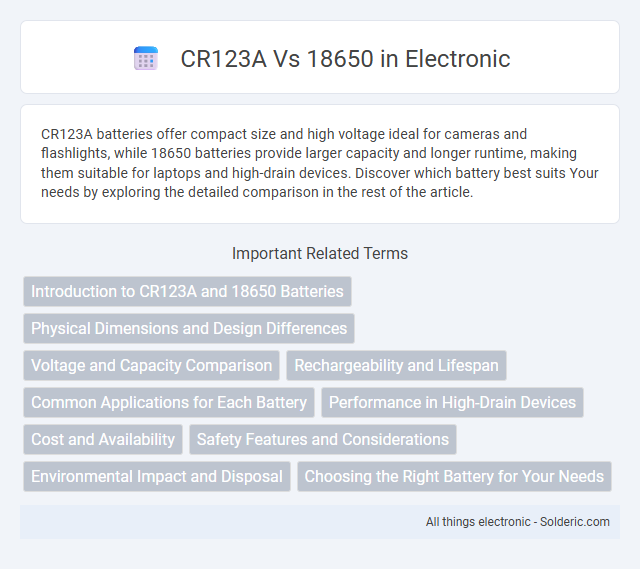CR123A batteries offer compact size and high voltage ideal for cameras and flashlights, while 18650 batteries provide larger capacity and longer runtime, making them suitable for laptops and high-drain devices. Discover which battery best suits Your needs by exploring the detailed comparison in the rest of the article.
Comparison Table
| Feature | CR123A | 18650 |
|---|---|---|
| Battery Type | Lithium Primary | Lithium-ion Rechargeable |
| Voltage | 3V | 3.6V - 3.7V |
| Capacity | 1400mAh - 1600mAh | 1800mAh - 3500mAh |
| Size (Diameter x Length) | 17mm x 34.5mm | 18mm x 65mm |
| Rechargeable | No | Yes |
| Typical Use | Flashlights, Cameras, Security Devices | Laptops, Flashlights, E-cigarettes, Power Tools |
| Weight | 16-20 grams | 40-50 grams |
| Max Continuous Discharge | Up to 1.5A | Up to 20A (depends on model) |
| Price | Higher per use (non-rechargeable) | Higher initial cost, rechargeable |
Introduction to CR123A and 18650 Batteries
CR123A batteries are compact, 3V lithium primary cells commonly used in cameras, flashlights, and security devices due to their high energy density and reliable performance in extreme temperatures. The 18650 battery is a larger, rechargeable 3.6-3.7V lithium-ion cell favored for high-drain devices such as laptops, electric vehicles, and power tools, offering greater capacity and longer lifecycle than CR123A cells. Both batteries provide distinct advantages based on size, voltage, and rechargeability, tailoring their use to specific electronic applications and power needs.
Physical Dimensions and Design Differences
The CR123A battery measures approximately 34.5mm in length and 17mm in diameter, featuring a compact, cylindrical design ideal for small devices like cameras and flashlights. In contrast, the 18650 battery is larger, with dimensions around 65mm in length and 18mm in diameter, designed for high-capacity applications such as laptops and electric vehicles. Understanding these physical dimensions and design differences helps you select the right battery for your device based on size constraints and power requirements.
Voltage and Capacity Comparison
CR123A batteries typically offer a voltage of 3V with a capacity around 1500mAh, making them ideal for compact devices. In contrast, 18650 rechargeable batteries provide a nominal voltage of 3.7V and a much higher capacity that often ranges from 2000mAh to 3500mAh, delivering longer runtime for power-hungry gadgets. Your decision between CR123A and 18650 batteries should consider required voltage compatibility and desired capacity for optimal device performance.
Rechargeability and Lifespan
CR123A batteries are typically non-rechargeable lithium primary cells with a lifespan suited for single-use applications, while 18650 batteries are rechargeable lithium-ion cells designed for multiple charge cycles, often exceeding 500 to 1000 cycles. Your choice between CR123A and 18650 should consider the longer lifespan and cost-effectiveness of 18650 batteries due to their rechargeability, versus the convenience and immediate availability of CR123A cells for devices requiring non-rechargeable power sources. Rechargeable 18650 batteries also offer better energy efficiency and environmental benefits compared to disposable CR123A batteries.
Common Applications for Each Battery
CR123A batteries are commonly used in high-performance flashlights, security cameras, and smoke detectors due to their compact size and high voltage output. In contrast, 18650 batteries are prevalent in laptops, electric vehicles, and high-capacity power banks, offering larger capacity and rechargeable capabilities. The CR123A's disposable nature suits devices requiring long shelf life, while the 18650 supports devices demanding sustained power and repeated recharging.
Performance in High-Drain Devices
CR123A batteries offer excellent performance in high-drain devices due to their high voltage of 3V and stable output, making them ideal for flashlights and cameras. However, 18650 batteries provide superior capacity and rechargeable convenience with 3.6-3.7V nominal voltage, delivering longer run times and better efficiency in power-hungry applications. Your choice depends on whether you prioritize quick replacement and reliability (CR123A) or higher capacity and rechargeability (18650) for optimal performance.
Cost and Availability
CR123A batteries typically cost more per unit and have limited availability compared to 18650 rechargeable lithium-ion batteries, which are widely produced and sold in bulk. The 18650 offers a more cost-effective solution for frequent use due to its rechargeable nature and longer lifespan. While CR123A batteries are commonly used in specialty devices, 18650 batteries dominate markets for electronics requiring high capacity and rechargeability.
Safety Features and Considerations
CR123A batteries offer enhanced safety with built-in over-discharge protection and a sealed design that reduces leakage risk, making them ideal for high-drain devices. 18650 lithium-ion cells require external circuit protection, including overcharge, over-discharge, and short-circuit safeguards, to ensure safe operation due to their higher energy density. Understanding these safety features is crucial for selecting the appropriate battery type for specific applications, especially in high-power or sensitive electronic devices.
Environmental Impact and Disposal
CR123A batteries contain lithium manganese dioxide and are typically single-use, creating more environmental waste compared to rechargeable 18650 lithium-ion batteries, which can be reused multiple times, reducing landfill contributions. Improper disposal of CR123A batteries risks releasing harmful lithium and heavy metals, while recycling centers often accept 18650 cells, allowing recovery of valuable materials and minimizing ecological harm. Choosing rechargeable 18650 batteries can significantly lower your carbon footprint and support sustainable disposal practices in electronic device usage.
Choosing the Right Battery for Your Needs
CR123A batteries deliver high voltage (3V) and excellent shelf life, making them ideal for compact devices like cameras and flashlights requiring reliable, short-term power. 18650 lithium-ion batteries offer significantly higher capacity (typically 2500-3500mAh) and rechargeable convenience, suited for power-hungry electronics and extended use. Evaluating device compatibility, required runtime, and rechargeability ensures selecting the right battery between disposable CR123A and rechargeable 18650 options.
CR123A vs 18650 Infographic

 solderic.com
solderic.com